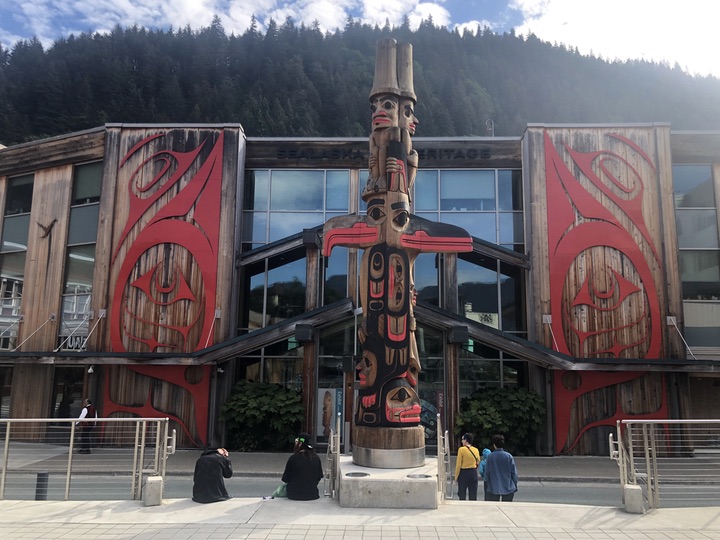The two big changes I noticed… returning to my former hometown of Juneau, Alaska for the first time in six years…
1. A downtown overrun by tourist gift shops, especially jewelry stores.
Juneau once had a functional downtown, with drug stores, liquor stores, book stores, housewares, grocery stores, restaurants. Now it’s basically just one gift shop after another.
I’m guessing that, out of the dozens of gift shops along South Franklin Street (near the dock where the cruise ship passengers disembark) maybe 80% of the shops sell jewelry that appears to have little or no connection to Alaskan culture — presumably manufactured in China, India or Italy. (The three countries that produce most of the world’s luxury jewelry.)
Collectable Alaskan t-shirts are another popular item, priced as low as $6.99.
Alaskan baseball caps from $4.99.
Plush Alaskan animals (moose, seals, huskies, puffins, etc.) from $8.99.
Something for everyone in the family, back in Florida.
The other big change I noticed:
2. Northwest Coast Indian artwork, everywhere. (Except in the jewelry stores.)
For example. Twenty or so new totem poles, all across town… eight to twenty-five feet tall… of impressive artistic quality and workmanship.
The totem poles are not the only public art celebrating the highly-stylized designs of the Northwest Coast.
The art also finds a home on the exteriors of downtown buildings, and on signs, and on business logos.
Traditionally, a Tlingit or Haida art object is related to a particular tribal legend or story, and includes only stylized animals and humans.
To my surprise, one of the poles I came across while walking along the cruise ship dock, included… ‘stars’. With little faces, of course.
I’d never before seen a totem pole that included ‘stars’. I wondered if they may have been included as a reference to the Alaskan flag, which consists of the Big Dipper and the North Star — eight yellow stars on a dark blue field. The Totemic Being holding the stars in this totem pole is Raven… the Trickster, and also the mythical creature who created the World, and who placed the Sun, the Moon and Stars in the Sky.
At the bottom of the same pole was another curious detail. A traditional wooden storage box.
Perhaps the very Box that held the Stars, before Raven released them into the Sky?
I was delighted to notice the box, because just a few minutes earlier, I had chanced to peek into a woodworking studio and come across a friend of my daughters, Lily and Ursala: artist and teacher Shgen George. She and a group of Juneau school teachers were learning to construct traditional ‘bend-wood’ storage boxes.
As Shgen explained, the teachers were all math teachers, and they will be developing a math curriculum that includes calculations related to the design of a traditional Tlingit ‘bent-wood’ boxes.
Practical mathematics, in other words, with a cultural component. The kind of ‘cross-cultural’ effort that seems to be ever more prevalent in Alaska.
As I mentioned yesterday in Part Two, when I first arrived in Juneau in 1971 as a college dropout looking for real adventure (something college had failed to provide) there were maybe four or five totem poles in town, of relatively modest artistic quality (compared to the poles I was able to photograph in 2023).
The little plastic totem poles available in the half dozen downtown gift shops, in 1971, were of even poorer design. The most elegant Tlingit artwork, back then, was generally found on hand-carved silver brackets, also on display in a few gift shops.
The creation of Northwest-style art and the conduct of American Indian cultural ceremonies had been actively suppressed in Alaska for the past 100 years, but racism was on the decline in 1971, and the Tlingit and Haida Indians were beginning a cultural revival of art, song, and ceremony. An intentional revival of the repressed Tlingit language commenced soon after.
The two largest artworks I came across during the trip to Juneau were a humpback whale ‘fountain’ near the Juneau-Douglas bridge…
… and a massive 25-foot-by-60 foot wall mural, on the south side of the Juneau Library, celebrating Elizabeth Peratrovich, American civil rights activist, Grand President of the Alaska Native Sisterhood, and member of the Tlingit nation. She passed away in 1958.
The mural is a curious mix of photo-realism with, in the background, traditional Northwest Coast formline designs of a Sockeye Salmon and Raven — Peratrovich’s clan crests… and at the bottom, cartoonish waves emblazoned with red circles representing salmon eggs.
To add to the mixed metaphor, Ms. Peratrovich’s head is surrounded by a gold halo reminiscent of the religious icons found in the Russian Orthodox churches located in towns and villages throughout Alaska.
Something for everyone in the family, you might say.
Crystal Kaakeeyáa Worl, a Tlingit and Athabascan artist, created the mural to celebrate Ms. Peratrovich, a fellow member of the Lukaax.ádi clan.
As I write this Part Three, I’m sitting in the airport heading back to Pagosa, and I’m thinking about how relatively rare it is, to find in Colorado communities, artworks and cultural references to the the Indigenous tribes that lived here in the American Southwest… and still live here.





















